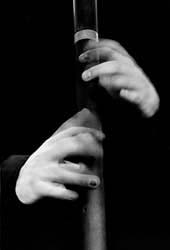
|
The recorders of the Middle Ages and the Renaissance are significantly different from their High Baroque suc- cessors both in appearance and sound. Differences are to be found both in their internal bore and outward appearance. Like so many of the instruments today con- sidered to be European, the recorder has its roots in the Oriental-Asian area. It was introduced to Europe on the one hand by the Moors via Spain and on the other hand by slaves from the East. It is to be found in many shapes and forms in illustrations, sculpture and literary descrip- tions. The form always used in art music had a thumb hole at the back and seven finger holes on the front. The number of holes varies widely in instruments used in folk and popular music (sometimes without a thumb hole), and the instruments are often made of reeds. Players of recorders were often associated with the attributes "disreputable" and "lascivious". The instrument was frequently considered to be a tool of the devil. Unfortu- nately only fragments of recorders from the Middle Ages still exist. Two complete instruments from the 14th and 15th centuries respectively have been preserved, but unfortunately they are unplayable. Thus reconstructed instruments have to be based solely on the inter- pretation of preserved specimens, illustrations and descriptions. |
|||||||